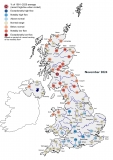Submitted by Katie Muchan on
September was a typical autumnal month with cool and unsettled conditions, although interrupted by a more settled and warm period mid-month. Consequently, rainfall was moderately below average at the national scale and less than half of the September average across a large swathe of eastern Scotland and central and southern England (and less than a third of average in isolated areas). Soil moisture deficits (SMDs) increased in most regions of the UK and soils were drier than average with the exception of some western areas where soils remained wetter than average. River flows were in the normal range across most of the UK with below average flows in parts of northern Scotland and the English Lowlands. Groundwater levels generally continued to recede during September, with index sites in the Chalk remaining in the normal range or below and levels generally in the normal range or above in other aquifers. Reservoir stocks declined at the majority of impoundments, but were moderately above average at the national scale, substantially so in some reservoirs in northern Britain and Northern Ireland. In contrast, stocks continued to fall substantially at Ardingly and levels were the lowest for September in a series from 1988. Whilst September was drier than average at the national scale and there were localised low reservoir stocks and groundwater levels, rainfall for the summer was above average and storm ‘Alex’ brought substantial rainfall totals at the start of October. The water resources situation therefore remains healthy for the winter half-year ahead, with the situation for 2021 in south-east England dependent on the timing of the onset of the groundwater recharge season.



